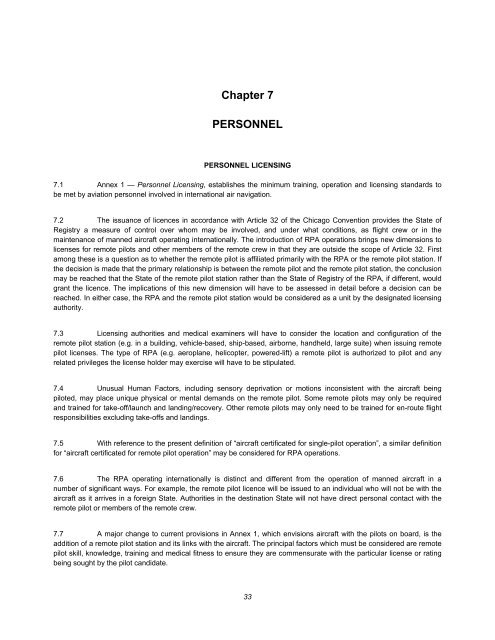1AswVkP
1AswVkP
1AswVkP
You also want an ePaper? Increase the reach of your titles
YUMPU automatically turns print PDFs into web optimized ePapers that Google loves.
Chapter 7<br />
PERSONNEL<br />
PERSONNEL LICENSING<br />
7.1 Annex 1 — Personnel Licensing, establishes the minimum training, operation and licensing standards to<br />
be met by aviation personnel involved in international air navigation.<br />
7.2 The issuance of licences in accordance with Article 32 of the Chicago Convention provides the State of<br />
Registry a measure of control over whom may be involved, and under what conditions, as flight crew or in the<br />
maintenance of manned aircraft operating internationally. The introduction of RPA operations brings new dimensions to<br />
licenses for remote pilots and other members of the remote crew in that they are outside the scope of Article 32. First<br />
among these is a question as to whether the remote pilot is affiliated primarily with the RPA or the remote pilot station. If<br />
the decision is made that the primary relationship is between the remote pilot and the remote pilot station, the conclusion<br />
may be reached that the State of the remote pilot station rather than the State of Registry of the RPA, if different, would<br />
grant the licence. The implications of this new dimension will have to be assessed in detail before a decision can be<br />
reached. In either case, the RPA and the remote pilot station would be considered as a unit by the designated licensing<br />
authority.<br />
7.3 Licensing authorities and medical examiners will have to consider the location and configuration of the<br />
remote pilot station (e.g. in a building, vehicle-based, ship-based, airborne, handheld, large suite) when issuing remote<br />
pilot licenses. The type of RPA (e.g. aeroplane, helicopter, powered-lift) a remote pilot is authorized to pilot and any<br />
related privileges the license holder may exercise will have to be stipulated.<br />
7.4 Unusual Human Factors, including sensory deprivation or motions inconsistent with the aircraft being<br />
piloted, may place unique physical or mental demands on the remote pilot. Some remote pilots may only be required<br />
and trained for take-off/launch and landing/recovery. Other remote pilots may only need to be trained for en-route flight<br />
responsibilities excluding take-offs and landings.<br />
7.5 With reference to the present definition of “aircraft certificated for single-pilot operation”, a similar definition<br />
for “aircraft certificated for remote pilot operation” may be considered for RPA operations.<br />
7.6 The RPA operating internationally is distinct and different from the operation of manned aircraft in a<br />
number of significant ways. For example, the remote pilot licence will be issued to an individual who will not be with the<br />
aircraft as it arrives in a foreign State. Authorities in the destination State will not have direct personal contact with the<br />
remote pilot or members of the remote crew.<br />
7.7 A major change to current provisions in Annex 1, which envisions aircraft with the pilots on board, is the<br />
addition of a remote pilot station and its links with the aircraft. The principal factors which must be considered are remote<br />
pilot skill, knowledge, training and medical fitness to ensure they are commensurate with the particular license or rating<br />
being sought by the pilot candidate.<br />
33


